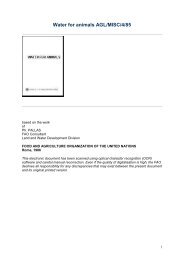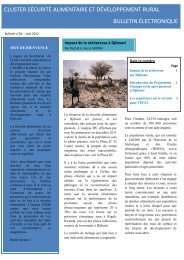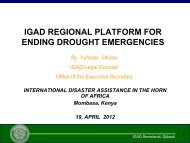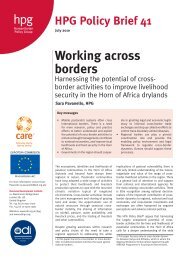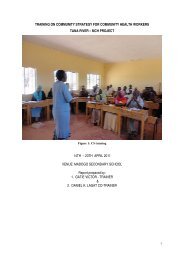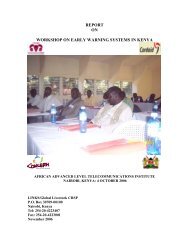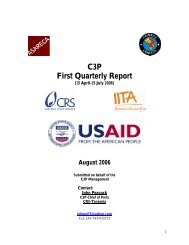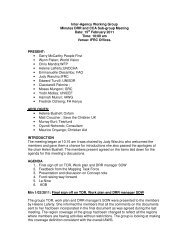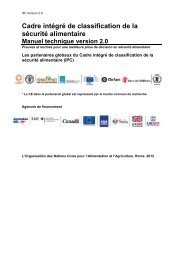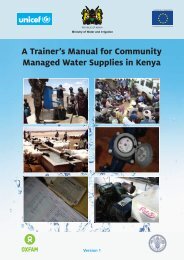Synthesis of Existing Knowledge and Experience on the Provision of ...
Synthesis of Existing Knowledge and Experience on the Provision of ...
Synthesis of Existing Knowledge and Experience on the Provision of ...
Create successful ePaper yourself
Turn your PDF publications into a flip-book with our unique Google optimized e-Paper software.
Agreed up<strong>on</strong> guidelines for water development in pastoral areas do not exist in Ethiopia. This als<str<strong>on</strong>g>of</str<strong>on</strong>g>rustrates moves towards streamlining practice across <strong>the</strong> water development sector. However,<strong>the</strong>re are a number <str<strong>on</strong>g>of</str<strong>on</strong>g> existing guidelines <strong>on</strong> water, participatory mapping <str<strong>on</strong>g>and</str<strong>on</strong>g> c<strong>on</strong>flict sensitiveplanning 4 . These may prove useful as a foundati<strong>on</strong> <strong>on</strong> which to build a broadly applicable set <str<strong>on</strong>g>of</str<strong>on</strong>g>guidelines for water development for productive use, which are versatile enough to allow c<strong>on</strong>textspecific planning in pastoral rangel<str<strong>on</strong>g>and</str<strong>on</strong>g>s. These guidelines could <strong>the</strong>n be mainstreamed into practicethrough <strong>the</strong> multiple existing coordinati<strong>on</strong> groups c<strong>on</strong>cerned with development <str<strong>on</strong>g>and</str<strong>on</strong>g> developmentorientedemergency relief in pastoral areas. Doing so could redress <strong>the</strong> fact that <strong>the</strong>re are currentlyno specific coordinati<strong>on</strong> efforts <strong>on</strong> water for productive use in <strong>the</strong> rangel<str<strong>on</strong>g>and</str<strong>on</strong>g>s, <str<strong>on</strong>g>and</str<strong>on</strong>g> in turn nocoherence across agencies <str<strong>on</strong>g>and</str<strong>on</strong>g> no comm<strong>on</strong> set <str<strong>on</strong>g>of</str<strong>on</strong>g> indicators <str<strong>on</strong>g>of</str<strong>on</strong>g> success.Despite l<strong>on</strong>ger-term developments beginning to emphasize s<str<strong>on</strong>g>of</str<strong>on</strong>g>tware aspects <str<strong>on</strong>g>of</str<strong>on</strong>g> design, such projects<str<strong>on</strong>g>and</str<strong>on</strong>g> programs are dwarfed in number by <strong>the</strong> more widespread short-term emergency relief projects.The short term nature <str<strong>on</strong>g>of</str<strong>on</strong>g> emergency relief compels implementing agencies to address watershortages <str<strong>on</strong>g>and</str<strong>on</strong>g> meet targets at <strong>the</strong> expense <str<strong>on</strong>g>of</str<strong>on</strong>g> appropriate planning <str<strong>on</strong>g>and</str<strong>on</strong>g> ensuring sustainability, whichrequires much more time. The need to streng<strong>the</strong>n linkages <str<strong>on</strong>g>and</str<strong>on</strong>g> improve complementarities betweenhumanitarian <str<strong>on</strong>g>and</str<strong>on</strong>g> development approaches <str<strong>on</strong>g>and</str<strong>on</strong>g> activities is recognized, <str<strong>on</strong>g>and</str<strong>on</strong>g> <strong>the</strong>re is interest am<strong>on</strong>ghumanitarian d<strong>on</strong>ors to improve <strong>the</strong> effectiveness <str<strong>on</strong>g>of</str<strong>on</strong>g> emergency interventi<strong>on</strong>s by tapping into <strong>the</strong>experience <str<strong>on</strong>g>of</str<strong>on</strong>g> development programs. For example, using impact assessments from developmentoriented programs is being explored to help gauge <strong>the</strong> impact <str<strong>on</strong>g>of</str<strong>on</strong>g> emergency relief interventi<strong>on</strong>s <strong>on</strong>livelihoods. Fur<strong>the</strong>rmore, an emerging trend observed in <strong>the</strong> last 10 years is <strong>the</strong> introducti<strong>on</strong> <str<strong>on</strong>g>of</str<strong>on</strong>g> al<strong>on</strong>ger term livelihoods approach to humanitarian interventi<strong>on</strong>s in some programs. There are also anumber <str<strong>on</strong>g>of</str<strong>on</strong>g> cases <str<strong>on</strong>g>of</str<strong>on</strong>g> NGOs using <strong>the</strong>ir experience with communities in a humanitarian relief c<strong>on</strong>textas an entry point for l<strong>on</strong>ger term development.Earlier-menti<strong>on</strong>ed shifts in thinking generally represent what practiti<strong>on</strong>ers in Ethiopia c<strong>on</strong>sider goodpractice in <strong>the</strong> water development arena. But as menti<strong>on</strong>ed, very little is d<strong>on</strong>e in <strong>the</strong> way <str<strong>on</strong>g>of</str<strong>on</strong>g>measuring impact <strong>on</strong> livelihoods. Using impact assessments can help guide practiti<strong>on</strong>ers towardsusing evidence based ‘best practice,’ <str<strong>on</strong>g>and</str<strong>on</strong>g> can help <strong>the</strong>m better navigate evolving livelihood <str<strong>on</strong>g>and</str<strong>on</strong>g>natural resource c<strong>on</strong>texts as each additi<strong>on</strong>al generati<strong>on</strong> puts fur<strong>the</strong>r dem<str<strong>on</strong>g>and</str<strong>on</strong>g> <strong>on</strong> existing resources.Water development can potentially undermine ra<strong>the</strong>r than promote development in pastoral regi<strong>on</strong>sif local needs, l<str<strong>on</strong>g>and</str<strong>on</strong>g> use patterns, livelihood systems, <str<strong>on</strong>g>and</str<strong>on</strong>g> ecological functi<strong>on</strong>s (<str<strong>on</strong>g>and</str<strong>on</strong>g> <strong>the</strong> relati<strong>on</strong>shipbetween <strong>the</strong>m) are not sufficiently understood <str<strong>on</strong>g>and</str<strong>on</strong>g> c<strong>on</strong>sidered. A fragmented approach to waterdevelopment also c<strong>on</strong>tributes to entrenching bad practice. The following table outlines comm<strong>on</strong>practice, potential outcomes <str<strong>on</strong>g>and</str<strong>on</strong>g> recommendati<strong>on</strong>s:4 These include <strong>the</strong> Ministry <str<strong>on</strong>g>of</str<strong>on</strong>g> Water Resources’ Implementati<strong>on</strong> Guidelines for Water Supply, Sanitati<strong>on</strong> <str<strong>on</strong>g>and</str<strong>on</strong>g>Hygiene Projects in Pastoral Areas (2006), <strong>the</strong> Ministry <str<strong>on</strong>g>of</str<strong>on</strong>g> Agriculture <str<strong>on</strong>g>and</str<strong>on</strong>g> Rural Development’s Nati<strong>on</strong>alGuidelines for Livestock Relief Interventi<strong>on</strong>s in Pastoralist Areas <str<strong>on</strong>g>of</str<strong>on</strong>g> Ethiopia (2008), <strong>the</strong> internati<strong>on</strong>al LivestockEmergency Guidelines <str<strong>on</strong>g>and</str<strong>on</strong>g> St<str<strong>on</strong>g>and</str<strong>on</strong>g>ards (2009), <strong>the</strong> internati<strong>on</strong>al humanitarian Sphere guidelines which include asecti<strong>on</strong> <strong>on</strong> water, sanitati<strong>on</strong> <str<strong>on</strong>g>and</str<strong>on</strong>g> hygiene, Catholic Relief Services’ Guidelines for <strong>the</strong> Development <str<strong>on</strong>g>of</str<strong>on</strong>g> Small-Scale Rural Water Supply <str<strong>on</strong>g>and</str<strong>on</strong>g> Sanitati<strong>on</strong> Projects in East Africa (2005), <strong>the</strong> SC-US <str<strong>on</strong>g>and</str<strong>on</strong>g> ELSE/ELMT TechnicalWorking Group led introductory volume <str<strong>on</strong>g>and</str<strong>on</strong>g> guidelines <strong>on</strong> participatory rangel<str<strong>on</strong>g>and</str<strong>on</strong>g> management (forthcoming,2010), <strong>the</strong> guidelines <strong>on</strong> participatory resource mapping developed independently by <strong>the</strong> government’sProductive Safety Net Program <str<strong>on</strong>g>and</str<strong>on</strong>g> USAID’s Pastoral Livelihoods Initiative, <str<strong>on</strong>g>and</str<strong>on</strong>g> CARE’s Guidelines for C<strong>on</strong>flictSensitive Programming (2008).14



